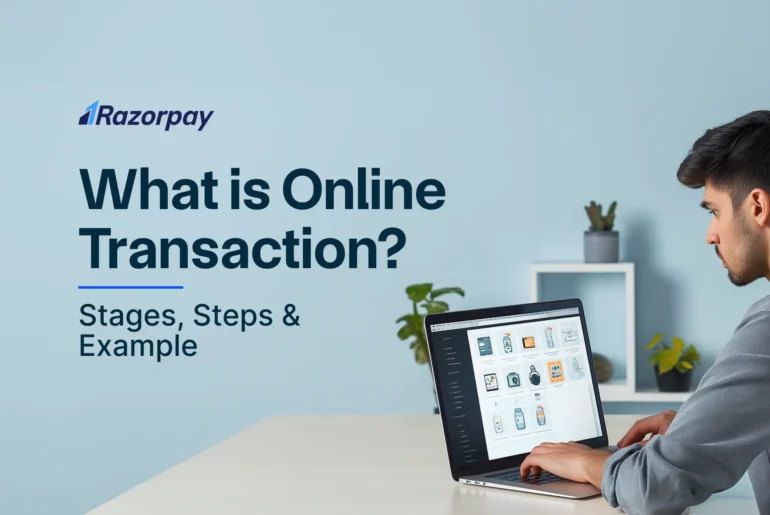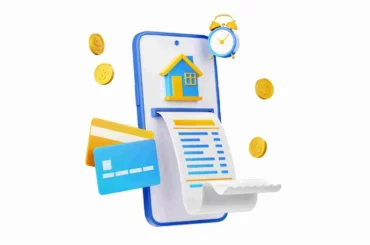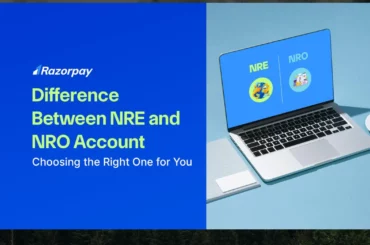Table of Contents
What is an Online Transaction?
Online transactions are a payment method where money or funds are transferred electronically using options like RTGS, IMPS, NEFT, UPI, cards, and similar methods.
It is the process of exchanging money or goods between two or more parties over the internet. It can involve various activities, such as buying and selling via e-commerce platforms, paying bills, transferring funds, donating to charities, and more.
These transactions offer convenience and accessibility to people who want to engage in financial activities from the convenience of their homes. You can perform transactions anytime and anywhere, as long as there is an internet connection and a suitable payment method.
Digital transactions also reduce the need for physical cash, paper checks, or postage stamps, making them more efficient and eco-friendly.
What Is Online Transaction Number?
An online transaction number, also known as a transaction ID, is a unique alphanumeric code assigned to each online transaction. It acts like a digital receipt that helps to track and confirm transactions, providing a digital “paper trail” for both consumers and businesses.
These numbers enhance transparency and accountability in online financial activities, as they show the date, time, amount, and parties involved in the transaction.
Online transaction numbers also contribute to fraud prevention and dispute resolution by offering a verifiable record of the transaction details. If there is any discrepancy or dispute, this number can be used to trace the transaction and resolve the issue.
Online transaction numbers are usually generated by the payment service provider or the bank that processes the transaction.
Related Read: What is UPI Reference Number and How to Track it?
Stages of Online Transaction
The online transaction involves three main stages such as pre-purchase/sale stage, purchase/sale stage, and delivery stage.
1. Pre-purchase/Sale Stage
This is the stage where you, as a customer, decide whether to proceed with a purchase. It is essential to set the foundation for a successful online transaction by providing precise and accurate information about the product or service, such as its features, benefits, price, availability, and delivery options.
Being a customer, you also need to trust the seller and the payment platform and feel secure about their personal and financial data.
2. Purchase/Sale Stage
This is the stage where you, as a customer, acquire the desired product or service. You need to select the product or service, add it to your shopping cart, and proceed to the payment gateway. You also need to provide your personal and delivery details and choose your preferred payment method; you may opt for online card payment.
Next, the payment platform verifies the payment and confirms the transaction. The seller must also send a confirmation email or message to you and provide a receipt and an invoice.
3. Delivery Stage
This is the phase following the purchase where the product or service is provided to you.
The seller should ensure that the product is delivered on time and in perfect condition and meets the customer’s expectations. The customer should also be able to track the delivery status and contact the seller or the courier service if there are any issues or delays.
The seller must also follow up with the customer, ask for feedback or reviews, and offer after-sales service and support. The customer should also be able to return or exchange the product or service if they are not satisfied and receive a refund or a replacement.
Related Read: What is TPT Transfer in Banking? – Methods, Limit & Fees
What Are The Steps Involved in an Online Transaction?
1. Registration
Registration is the process of creating an account with your personal information, such as your name, email, and password.
Registration helps save your payment information, address book, and order tracking features for future transactions. It also enables you to receive notifications and offers from the seller.
However, registration also requires you to share your personal information with the seller, be careful about what information you provide and how the seller uses it. It is also important to employ strong password practices, like incorporating a mix of letters, numbers, and symbols and periodically changing your password, to bolster the security of your registered account.
2. Placing an Order
Add the products you wish to purchase by tapping on the “Add to Cart” button.
Once you have added the products or services to your cart, you can move to the checkout page by selecting the “Checkout” button. On this page, you can review your order specifics, including the products or services, their prices, the shipping fees, and any applicable taxes.
3. Payment
Payment is transferring money from your credit card, bank account, debit card, or any other payment system to the seller’s account. Payment is the most crucial step of online transactions, as it involves your financial data, such as your card number, expiry date, CVV, and PIN. You must ensure the best payment gateway page is secure and encrypted before entering your payment details. You can check the security of the payment page by looking for a padlock icon or a “https” prefix in the address bar of your browser.
To avoid online payment fraud, payment page security is vital for safeguarding your financial data. You should never share your payment details with anyone or enter them on unsecured or suspicious websites or apps. You should also avoid saving your payment details on the seller’s website or app, as this may increase the risk of data leaks.
What are the Accepted Payment Methods for Online Transactions?
Here are some of the most common methods:
1. Credit Cards and Debit Cards
These are the most widely accepted payment methods for online transactions. They offer convenience and security, as the payment is processed through a secure network.
2. E-wallets
Digital wallets like PayPal, Google Pay, and Apple Pay allow you to store your credit card or bank account information securely and use it to pay for online purchases without having to enter your details each time.
3. Bank Transfers
This method involves transferring money directly from your bank account to the merchant’s account. It can be a secure option, but it may take longer to process than other methods.
4. Buy Now, Pay Later
This method allows you to split your purchase into installments without any upfront interest.
5. Cash on Delivery (COD)
This method allows you to pay for your order in cash when it is delivered. However, it may not be available for all merchants or all products.
Read More: What are the 12 Types of Payment Methods?
Frequently Asked Questions (FAQs)
1. What Is the Limit of Online Transaction?
The online transaction limit depends on the mode of payment, the bank, and the merchant. For example, in UPI-based transactions, the limit is Rs 1 lakh. In the case of credit or debit cards, the limit is decided by the issuing bank.
2. Is it safe to make online transactions?
Online transactions are generally safe, encrypted and protected by various security measures. Still, take some precautionary measures like not sharing your PIN, OTP, CVV, or password with anyone. You must also avoid clicking on suspicious links or attachments in emails or messages.
3. What should I do if an online transaction fails?
If the transaction is unsuccessful, check the reason for the failure. If the transaction is debited from the user’s account but not credited to the merchant’s account, the user should contact the bank or the payment mode provider and complain.
4. How long does it take for an online transaction to be processed?
The processing time of an online transaction depends on the payment mode, the bank, and the merchant. Some payment modes, such as UPI, debit card, credit card, and net banking, are usually instant or take a few minutes to complete. However, some payment modes, such as NEFT, RTGS, IMPS, and cheque, may take longer, depending on the bank’s working hours, holidays, and cut-off timings.
5. What fees are associated with online transactions?
The fees associated with online transactions may vary depending on the payment mode, the bank, and the merchant.




